The Seimas (parliament of Lithuania) today issued this official English version of its ‘resolution on declaring the year 2011 as the year of remembrance for the victims of the Holocaust in Lithuania’. The succinct statement expresses ‘sincere respect for the victims of the Holocaust in Lithuania’, mentioning ‘the genocide perpetrated against Jews by Nazis and their collaborators in Lithuania during the occupation by Nazi Germany’.
It goes on, in Article 2, to propose that by 1 November 2010 there be a specific program approved, that will include Continue reading
Elie Valk, chairman of the Association of Latvian and Estonian Jews in Israel, released a statement with links to news reports of the opening of the first part of the Museum of Riga Ghetto today. The statement reports that ‘The idea of creating such a museum was circulating in the Jewish Community for three to four years. Finally Menachem Barkahan, head of the local religious congregation Shamir, picked it up and was successful in raising funds for it. He is the son of the late Rabbi Note Barkan, who served as the Chief Rabbi of Latvia’. The links provided to news of the event are:Continue reading
 Attorney Joseph Melamed, chairman of the Association of Lithuanian Jews in Israel (at right) delivered the keynote speech today at an event held at Yad Vashem in Jerusalem to mark the September 23rd anniversary of the 1943 liquidation of the Vilna Ghetto. Because of the Jewish holidays, the event was moved up to the 20th this year.
Attorney Joseph Melamed, chairman of the Association of Lithuanian Jews in Israel (at right) delivered the keynote speech today at an event held at Yad Vashem in Jerusalem to mark the September 23rd anniversary of the 1943 liquidation of the Vilna Ghetto. Because of the Jewish holidays, the event was moved up to the 20th this year.
Those in attendance included Uri Chanoch, chairman of the Holocaust Survivors’ Association; Mr Michael Schemyawitz (left of photo), head of the Association of Vilna Jews in Israel and director of its Beit Vilna premises in the Montefiore section of Tel Aviv; and the top leadership of Yad Vashem including chairman Avner Shalev and director general Nathan Eitan. The program of speakers and was released in advance (in Hebrew) by the ALJ. Lithuania’s ambassador to Israel, HE Darius Degutis, delivered a conciliatory address (full text here), which included the moving line: ‘It breaks my heart and casts a shadow of shame that among the perpetrators of these crimes were also my countrymen. This cannot be, and will not be, either forgotten or forgiven’.
Continue reading
 The Jewish Community of Lithuania issued an eloquent public statement on 7 Sept 2010 (English translation here), following the proliferation of comments from high society circles of politics, academia and the media which sanitize and in some instances glorify the Nazi-collaborationist Provisional Government (see for example here and here).
The Jewish Community of Lithuania issued an eloquent public statement on 7 Sept 2010 (English translation here), following the proliferation of comments from high society circles of politics, academia and the media which sanitize and in some instances glorify the Nazi-collaborationist Provisional Government (see for example here and here).
Often lurking just under the surface is the closely related question of the 1941 ‘L.A.F.’ (Lithuanian Activists’ Front), whose campaign of murder of Jewish civilians in effect launched the Lithuanian Holocaust. They too are glorified by various antisemitic historians and by the state sponsored Genocide Museum in the capital’s center.
The barbaric rampage of murder was underway before the arrival at these sites of Nazi German forces in late June of 1941 (background here; information on specific towns here). The far-right establishment has been looking for a quick sanitization of fascist heroes (recast as ‘brave anti-Soviet partisans’) in anticipation of the 70th anniversary of the events in 2011.
The state-sponsored Genocide Museum in the center of Vilnius fails to even mention the L.A.F.’s murderous role in initiating the Holocaust locally, referring to its members exclusively as anti-Soviet rebels (failing to mention only the ‘detail’ that the Soviets were fleeing the German Nazi invasion, not them). Continue reading
◊
VILNIUS—Esther Goldberg Gilbert, wife and partner to Sir Martin Gilbert and an accomplished Holocaust scholar in her own right, published a profile today of Rachel Kostanian, the widely admired director of Vilnius’s Green House, which many consider to be the only honest Holocaust exhibit or museum in the entire country. The PDF is available here, and a facsimile follows. Please use handles in the upper left hand corner to turn pages.
20108SeptGGoldergOnKostanian
An opposition party member of the Lithuanian Seimas (parliament) has leaked this memo (English translation here), dated 20 July 2010, which purports to be a circular letter from the deputy foreign minister, Sarunas Adomavicius, to the working group (names blocked out) of the ‘Fake Litvak’ Forum (the official name is the ‘Litvak Heritage Forum’). The Forum is viewed as a ploy to hijack Litvak identity and put it to use for government PR purposes.
The day it was announced, 15 July 2010, the prime minister’s chancellor boasted of ‘rich Litvaks’ having been found to finance it. Protests followed immediately from Holocaust Survivors of the ALJ, the Simon Wiesenthal Center, the Litvak Studies Institute and this website (see here). There is particular fear that it is to serve as cover to deflect attention from the ongoing Continue reading
A report in Jerusalem of Lithuania describes the most recent attacks on the offices of the small Jewish community that remains in Panevezys (Ponevezh). The report is available here.
The 2 September 2010 issue of the Baltic Times carried an unsigned editorial on the Opinion page that refers to Dr Efraim Zuroff, director of the Wiesenthal Center’s Israel office, and the author of Operation Last Chance [excerpt here], as someone who ‘plays Moscow’s political games’, in line with local far-right efforts to tar with a McCarthyist brush of alleged communism those who speak out against racism, antisemitism, and Holocaust revisionism.
Continue reading
Sir Martin Gilbert has today authorized publication of his 24 August 2008 letter to this journal’s (future) editor. The facsimile follows. The letter had confirmed his April 2008 resignation from the “International Commission for the Evaluation of the Crimes of the Nazi and Soviet Occupation Regimes in Lithuania” (known informally and for brevity as the “Red-Brown Commission”), citing the Yitzhak Arad affair.
In view of the subsequent developments, the 24 August letter also cites the need for the Commission to condemn the defamation of additional Holocaust survivors Fania Yocheles Brantsovsky, Professor Sara Ginaite, and Dr. Rachel Margolis. Professor Gilbert’s authorization for publication came after the Commission’s website failed to remove his name from the list of members in spite of his resignation on principle.
Continue reading
O P I N I O N
I will admit that when I read political analyst Kęstutis Girnius’s comments on the Lithuanian Provisional Government and the Lithuanian Activist Front, and about the supposedly low level of academic research and documentation of these phenomena, I found myself in a state of disbelief that a person whom I consider one of the most sober-minded and most insightful of our political commentators could write this. Without citing his earlier statements on radio and in publications on this topic, here is the link to Kęstutis Girnius’s latest commentary [English translation]:
Continue reading
O P I N I O N
by Dovid Katz
A ‘Lenin Statue Theme Park’ near the resort town of Druskininkai featuring: ‘Soviet Sculpture Exposition, Museum, Picture Gallery, Events, Cafes, Souvenirs, Lunapark, Zoo’ etc. Their website here. A summer 2010 visit.
Gruto Parkas (situated at Grutas, near Druskininkai and often popularly called ‘the Lenin Park’) is a private enterprise, but a large sign near the entrance boasts that the historical inscriptions were donated by the state-sponsored ‘Genocide and Resistance Research Centre of Lithuania’.
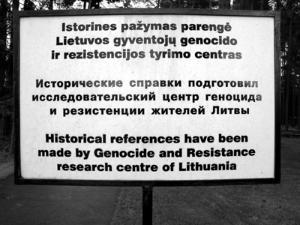
THE QUESTION: Can you imagine a major theme park dedicated to the history of the Soviet period, in a member state of the European Union and NATO, that tries its best to present Soviet Communism as a largely Jewish enterprise? With a presentation in the spirit of a most infamous brand of 20th century antisemitism? That singles out by nationality only Jews among the many ‘rogues’ featured in its exhibits? That defames the memory of Holocaust Survivors who escaped Nazi ghettos to join the anti-Nazi partisans in the forests of Lithuania? And all this, without once mentioning the Holocaust . . .
Continue reading
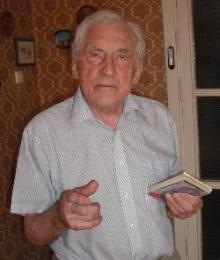 Joseph Levinson of Vilnius, born in March 1917 — an anti-Nazi war veteran, founding figure of Vilnius’s ‘Green House’, historian of the Lithuanian Holocaust, and author of The Book of Sorrow (Vilnius 1997) and The Shoah in Lithuania (English edition: Vilnius 2006) — was honored in London’s Central Synagogue at a splendid event on Wednesday evening 1 September 2010. Details here.
Joseph Levinson of Vilnius, born in March 1917 — an anti-Nazi war veteran, founding figure of Vilnius’s ‘Green House’, historian of the Lithuanian Holocaust, and author of The Book of Sorrow (Vilnius 1997) and The Shoah in Lithuania (English edition: Vilnius 2006) — was honored in London’s Central Synagogue at a splendid event on Wednesday evening 1 September 2010. Details here.
Elegantly chaired by the synagogue’s Rabbi Barry Marcus, a scion of luminous Lithuanian rabbis, himself born in South Africa, it included speeches by Iain Duncan Smith (‘IDS’), Britain’s Secretary of State for Work and Pensions, and the Israeli ambassador to the UK, HE Ron Prosor. The Central Synagogue’s hall was packed. [Added 20 September 2010: See the 2 Sept report in The Jewish News, and Simon Round’s interview with Mr Levinson in The Jewish Chronicle.]
Continue reading
Discontinuation of the contract of Lithuania’s last Jewish professor — Dovid Katz, founding Yiddish professor at the Vilnius Yiddish Institute and editor of this website — for having mounted a defense of the defamed Holocaust Survivors, and building (via the Vilnius diplomatic community, op-eds in mainstream publications, and this site) international opposition to the ‘Double Genocide’ movement in Europe, and in Lithuania.
Continue reading
Posted in "Jewish" Events as Cover?, A 21st Century Campaign Against Lithuanian Holocaust Survivors?, Bloomington-Borns Program Manipulated?, Human Rights, News & Views, Norway, Richard Maullin, Vilnius Yiddish Institute, Yiddish Affairs
|
Tagged AHEYM, Borns Jewish Studies Program, Dan Opatoshu, Dov-Ber Kerler, Judaicvilnius.com, Richard Maullin, Vilnius Yiddish Institute, Vilnius Yiddish Summer Program, VYI
|
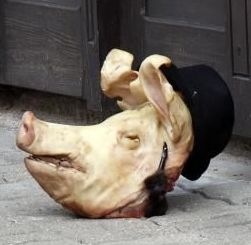 A pig’s head, adorned with a black hat and makeshift hasidic style earlocks, was placed on the pavement right outside the door, within the courtyard of the main synagogue in Kaunas, Lithuania’s second city, during Sabbath morning services. This caused profound grief to the very small congregation of survivors who pray at the city’s Choral Synagogue, the only prewar Jewish prayerhouse in town that still functions. The service was interrupted as police arrived to investigate. The Lithuanian Jewish Community described it as a neo-Nazi antisemitic attack. The police however told BNS that the incident ‘is still qualified as a disturbance of the public peace’. Moreover, the commander of the Central Police Commissariat Gintautas Dirmeikis told BNS that ‘There are no suspects so far’. Photo by Laimutis Brundza / Kauno diena.
A pig’s head, adorned with a black hat and makeshift hasidic style earlocks, was placed on the pavement right outside the door, within the courtyard of the main synagogue in Kaunas, Lithuania’s second city, during Sabbath morning services. This caused profound grief to the very small congregation of survivors who pray at the city’s Choral Synagogue, the only prewar Jewish prayerhouse in town that still functions. The service was interrupted as police arrived to investigate. The Lithuanian Jewish Community described it as a neo-Nazi antisemitic attack. The police however told BNS that the incident ‘is still qualified as a disturbance of the public peace’. Moreover, the commander of the Central Police Commissariat Gintautas Dirmeikis told BNS that ‘There are no suspects so far’. Photo by Laimutis Brundza / Kauno diena.
Continue reading
- O P I N I O N
- Questions from Mindaugas Peleckis and answers from Dovid Katz (Text of documents sent by email on 21 August 2010).
- [Update: This interview resulted in the article published in Čikagos aidas on 16 Dec 2010. The unabridged text was posted on this page on 23 Dec 2010, by agreement of the interviewer and the interviewee.]
1. I would like to talk to you about Jewish-Lithuanian relationships. You’ve published the wonderful book ‘Lithuanian Jewish Culture’, which sheds light on many things concerning Jewish life in Lithuania and around it. What do you think about when Lithuanians became, so to say, antisemitic? In the 19th and 20th centuries? Or earlier?
Continue reading
Letter to the Editor of the New York Times [not published; subsequently entered into the record on HITB for the date of submission]:
Human Rights — and Holocaust Obfuscation — in the Baltic States
To The Editor:
Clifford J. Levy’s fine report (Aug 16 [print edition]) on the humiliations suffered by native-born Estonians whose mother tongue is Russian is particularly important because Estonia is a member of NATO and the European Union, and its human rights policies are therefore automatically a matter for the collective conscience of these alliances and their individual members.
There is just one painful point on which the report accepts uncritically an Estonian (and generally a Baltic) ‘Excuse for Genocide’ that is verily inexcusable. “Before Estonia was seized by the Soviets in 1940, its population was largely ethnic Estonian; resentment was strong enough that many sided with the Germans when Hitler invaded in 1941.”
Actually, the demographic-balance threatening influx of Russian speakers from other Soviet republics came after World War II. But in any case, the idea that the Soviet occupation somehow justifies (or even explains) the Estonian Hitlerists’ (and Lithuanian and Latvian fascists’) gleeful mass murder of the women, children and men of their Jewish minority (making way, in the Baltics, for the highest percentages of Jews slaughtered in all of Holocaust-era Europe) is sheer nonsense. It is one of many ruses underway in the eastern reaches of the European Union to sanitize and obfuscate the Holocaust. Journalists must be sensitized to its box of semantic tricks.
Dovid Katz
Pamėnkalnio 12, Vilnius
Note: See also our report on the October 2010 re-opening of the Green House following extensive renovations. Black and white photos below are ©Richard Schofield.
 Rachel Kostanian, the courageous director, valiantly keeps alive one of the rare local bastions of public integrity on the Holocaust in Lithuania, having constantly to fend off obstacles. Read Esther Goldberg Gilbert’s portrait in the special Jewish New Year’s supplement on great Jewish women of the ages in the Canadian Jewish News (8 Sept 2010). A follow-up article on Rachel Kostanian’s epic struggle for truth in Holocaust history appeared a month later (7 Oct 2010).
Rachel Kostanian, the courageous director, valiantly keeps alive one of the rare local bastions of public integrity on the Holocaust in Lithuania, having constantly to fend off obstacles. Read Esther Goldberg Gilbert’s portrait in the special Jewish New Year’s supplement on great Jewish women of the ages in the Canadian Jewish News (8 Sept 2010). A follow-up article on Rachel Kostanian’s epic struggle for truth in Holocaust history appeared a month later (7 Oct 2010).
Continue reading
by Dovid Katz
◊
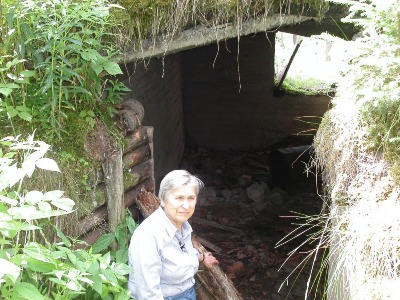
Fania Yocheles Brantsovsky, born in 1922, who lost her entire family in the Holocaust, escaped the Vilna Ghetto several moments before it was encircled by police preparing for its final liquidation on 23 September 1943. Together with Dobke Develtov [update: who passed away in 2012 in Los Angeles], she made it to this underground anti-Nazi partisan fort that was home to fighters aligned with the Soviet partisans. The precise number of inhabitants varied with newcomers and deaths in battle. Fania remembers at one time 99 of 101 were Jewish Vilna Ghetto escapees, at another 101 of 107. An underground bunker like this was home until the fall of Nazi rule in July 1944.
Along with other Holocaust Survivors who resisted — including Yitzhak Arad and Rachel Margolis — Ms Brantsovsky, librarian of the Vilnius Yiddish Institute, has in recent years been the object of a campaign of defamation and harassment in Lithuania.
The antisemitic press has targeted her (January 2008). Armed police came to search for her (May 2008). Prosecutors told the press she could not be found (May 2008). The editor of Lithuania’s main news portal called for her to be tried (May 2009). The mainstream media, citing ruling-party members of Lithuania’s parliament, branded her a war criminal (Oct 2009). And one of the country’s leading associations for human rights (!) demanded that she and other Jewish partisan veterans be ‘sentenced’ for committing ‘a massive slaughter’ (Dec. 2010).
All in the absence of any charge or iota of evidence.
Continue reading
◊
by Dovid Katz
◊

Fania Yocheles Brantsovsky, born in 1922, who lost her entire family in the Holocaust, escaped the Vilna Ghetto several moments before it was encircled by police preparing for its final liquidation on 23 September 1943. Together with Dobke Develtov [update: who passed away in 2012 in Los Angeles], she made it to this underground anti-Nazi partisan fort that was home to fighters aligned with the Soviet partisans. The precise number of inhabitants varied with newcomers and deaths in battle. Fania remembers at one time 99 of 101 were Jewish Vilna Ghetto escapees, at another 101 of 107. An underground bunker like this was home until the fall of Nazi rule in July 1944.
Along with other Holocaust Survivors who resisted — including Yitzhak Arad and Rachel Margolis — Ms Brantsovsky, librarian of the Vilnius Yiddish Institute, has in recent years been the object of a campaign of defamation and harassment in Lithuania.
The antisemitic press has targeted her (January 2008). Armed police came to search for her (May 2008). Prosecutors told the press she could not be found (May 2008). The editor of Lithuania’s main news portal called for her to be tried (May 2009). The mainstream media, citing ruling-party members of Lithuania’s parliament, branded her a war criminal (Oct 2009). And one of the country’s leading associations for human rights (!) demanded that she and other Jewish partisan veterans be ‘sentenced’ for committing ‘a massive slaughter’ (Dec. 2010).
All in the absence of any charge or iota of evidence.
“I dream that good people from all over the world will not forget the Holocaust in Lithuania or our struggle to stay alive and to fight the Nazis and their collaborators, that for generations to come they will make their way here to look and see where we, a hundred Vilna Ghetto survivors who lost our entire families, lived, loved, fought, and dreamt of a better tomorrow.” — Fania Yocheles Brantsovsky
Continue reading
 Attorney Joseph Melamed, chairman of the Association of Lithuanian Jews in Israel (at right) delivered the keynote speech today at an event held at Yad Vashem in Jerusalem to mark the September 23rd anniversary of the 1943 liquidation of the Vilna Ghetto. Because of the Jewish holidays, the event was moved up to the 20th this year.
Attorney Joseph Melamed, chairman of the Association of Lithuanian Jews in Israel (at right) delivered the keynote speech today at an event held at Yad Vashem in Jerusalem to mark the September 23rd anniversary of the 1943 liquidation of the Vilna Ghetto. Because of the Jewish holidays, the event was moved up to the 20th this year.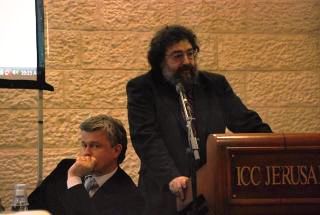


 A pig’s head, adorned with a black hat and makeshift hasidic style earlocks, was placed on the pavement right outside the door, within the courtyard of the main synagogue in Kaunas, Lithuania’s second city, during Sabbath morning services. This caused profound grief to the very small congregation of survivors who pray at the city’s Choral Synagogue, the only prewar Jewish prayerhouse in town that still functions. The service was interrupted as police arrived to investigate. The Lithuanian Jewish Community
A pig’s head, adorned with a black hat and makeshift hasidic style earlocks, was placed on the pavement right outside the door, within the courtyard of the main synagogue in Kaunas, Lithuania’s second city, during Sabbath morning services. This caused profound grief to the very small congregation of survivors who pray at the city’s Choral Synagogue, the only prewar Jewish prayerhouse in town that still functions. The service was interrupted as police arrived to investigate. The Lithuanian Jewish Community  Rachel Kostanian, the courageous director, valiantly keeps alive one of the rare local bastions of public integrity on the Holocaust in Lithuania, having constantly to fend off obstacles. Read Esther Goldberg Gilbert’s portrait in the special Jewish New Year’s supplement on great Jewish women of the ages in the
Rachel Kostanian, the courageous director, valiantly keeps alive one of the rare local bastions of public integrity on the Holocaust in Lithuania, having constantly to fend off obstacles. Read Esther Goldberg Gilbert’s portrait in the special Jewish New Year’s supplement on great Jewish women of the ages in the 